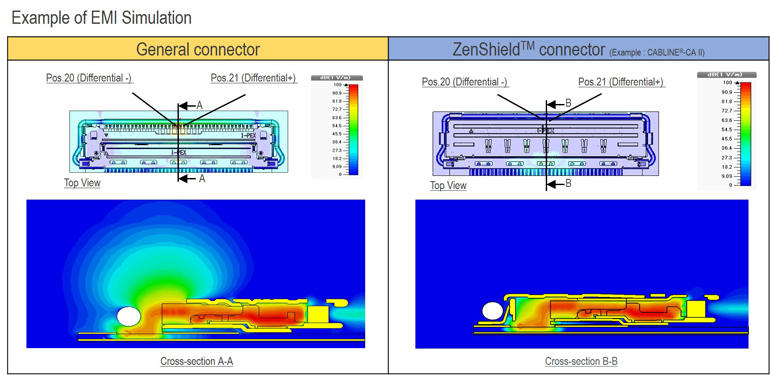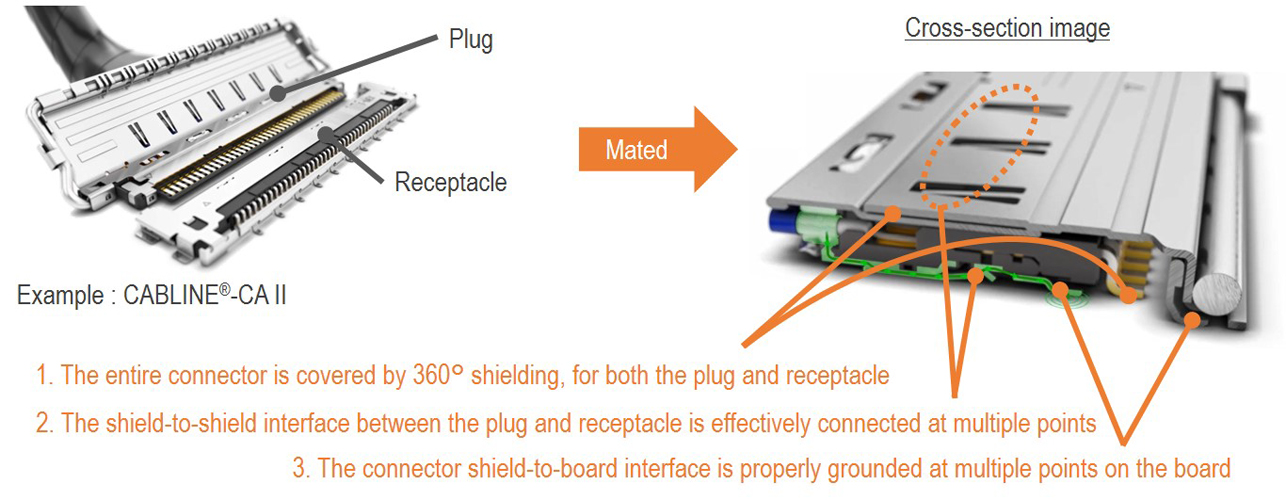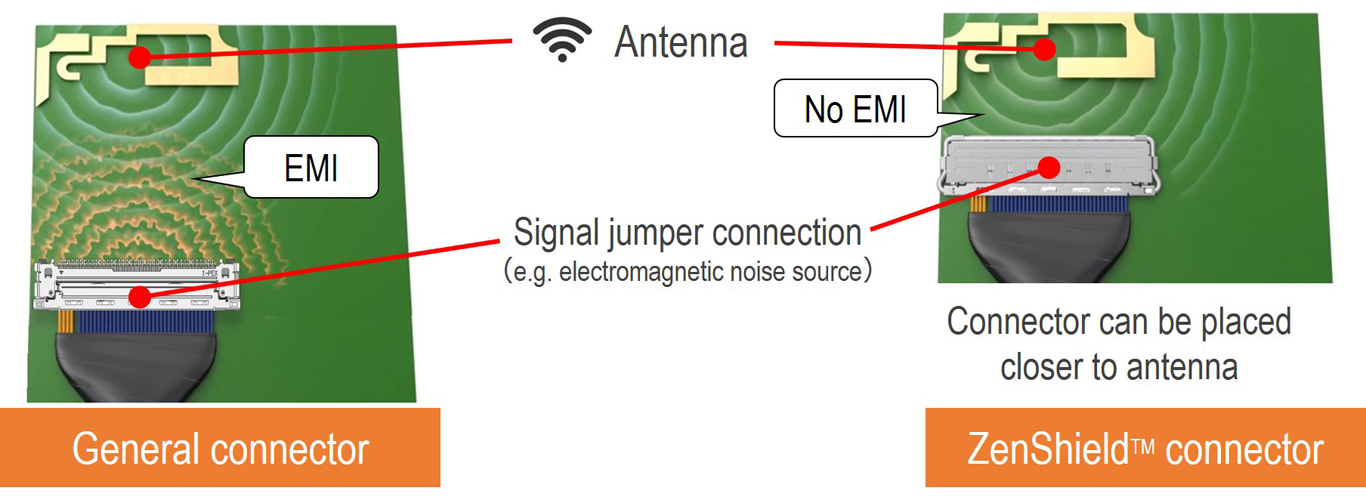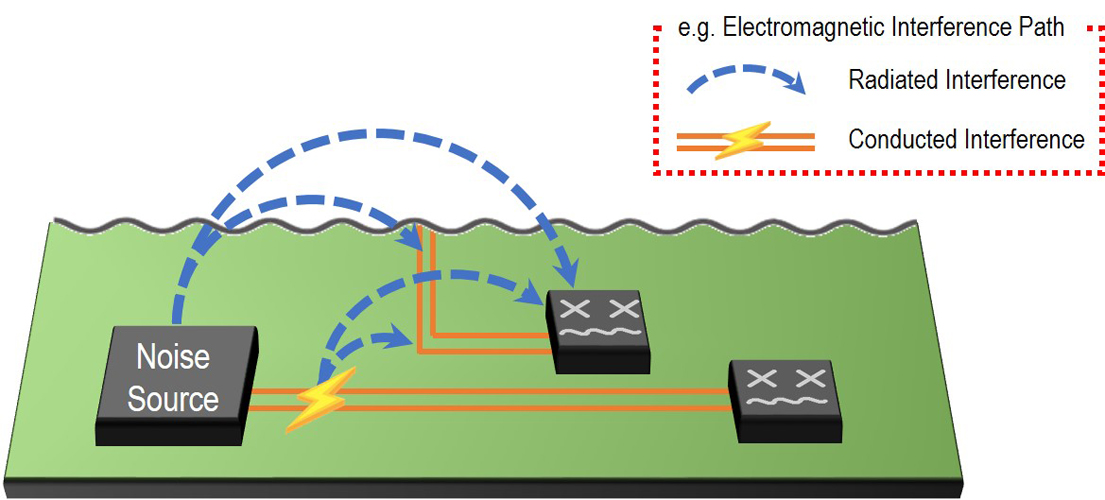
By Nick Murata, Website and Marketing Project Manager, I-PEX
ZenShield™ is the brand name for the I-PEX small connector series that includes high-performance EMI shielding design.

As high-speed internet improves and the usage of large-capacity memory devices increases, high-resolution images and videos can be enjoyed more easily on consumer products such as PCs, tablets and smartphones. The amount of information that needs to be processed on these devices has dramatically increased and the signal speed in the device has been getting faster and faster.
When electromagnetic noise is added from the outside in such electronic devices, unintended electrical signals may be induced to the circuits in the devices causing a malfunction or damage to high-performance electronic components which may also lead to electronic device breakage.
Other problems can occur when electromagnetic noise generated from the devices’ own internal digital timing signals or electronic components causes failure of other parts within the same system. This is called an intra-system EMC (Electromagnetic Compatibility) problem. It often causes headaches for engineers who must develop high-performance, hand-held or portable electronic devices, in which high density electronic components are mounted. When interconnects are required in these types of devices, EMI shielding connectors are often required in order to prevent electromagnetic noise from becoming a problem.
With its unique shielding designs, the I-PEX ZenShield connector series can provide excellent EMI countermeasures.
The 360-degree EMI shielding design prevents electromagnetic noise radiation not only from the contact points of the plug and receptacle, but also from the board mounting part (SMT positions) of the signal terminals. In addition, both plug and receptacle shields are properly connected for grounding at multiple points when the connectors are mated and are properly grounded to the board. This ensures enough ground return paths for the current generated in the metal shields of the connector. This works to suppress the emission of electromagnetic noise from its shield.
ZenShield Connector Series Design
- The entire connector is covered by 360° shielding, for both the plug and receptacle — not only the contact part of the signal terminal, but also the board mounting part (SMT positions).
- The shield-to-shield interface between the plug and receptacle is effectively connected at multiple points.
- Furthermore, the connector shield-to-board interface is properly grounded at multiple points on the board, thereby improving the ground return path.

With these design features, the connector itself provides significant mitigation of EMI. ZenShield gives board designers more flexibility for designing the board by allowing the connectors to be placed in close proximity to sensitive subsystems, such as transmit/receive antennas, that are commonly found in high-performance wireless communication systems. These types of systems typically require aggressive shielding solutions for intra-system EMI isolation problems.

Available ZenShield Connector Series
The I-PEX ZenShield connector series offers a number of EMI shielding connectors to meet various applications and design conditions.
Micro-Coaxial Connectors
- CABLINE®-CA II / CA II PLUS (0.4 mm pitch, horizontal mating type)
- CABLINE®-VS II (0.5 mm pitch, horizontal mating type)
- CABLINE®-UM (0.4 mm pitch, vertical mating type)
Board-to-Board (FPC) Connectors
- NOVASTACK® 35-HDP (0.35 mm pitch, with power supply terminal)
- NOVASTACK® 35-HDN (0.35 mm pitch, space saving design type)
FPC/FFC Connectors
- EVAFLEX® 5-HD (0.5 mm pitch, with auto-locking function)
- CABLINE®-CA IIF (0.4 mm pitch, horizontal mating type)
- CABLINE®-VS IIF (0.5 mm pitch, horizontal mating type)
RF Connector
- MHF® 7S (foot pattern 2.0 x 2.0 mm, compatible frequency up to 15 GHz)
Electromagnetic Interference (EMI)
There are two types of electromagnetic interference conduction paths: radiated and/or conducted.
- Radiated Interference occurs when high-frequency signals traveling on a conductive surface (or wire or pcb trace) generate a time-changing electromagnetic field. This electromagnetic field can be detected (radiates) some distance from that surface. The closer the distance between the source, and the adjacent surface (or wire or pcb trace), the larger will be the coupled field which can be detected. Since the adjacent surface is conductive, voltages and currents will be excited on it when in the presence of an electromagnetic field. Solutions for this normally require the use of shielded enclosures, cables, and connectors. If any one part of the system is unshielded, it will be a point of radiated EMI leakage.
- Conducted Interference occurs when intentional (or unintentional) signals in a circuit directly travel by conductor (or wire or pcb trace) from one place to another, in such a way as to interfere with the proper operation of the destination circuit or device. Incoming power lines are one such example of conducted interference. In this case, use of line filters, capacitor networks and similar methods are employed to separate (or condition) the intended voltage signals from the interference voltages.

Contact us to learn more about these connectors: https://bit.ly/3WKmBCr
Sponsored content by I-PEX

Leave a Reply
You must be logged in to post a comment.